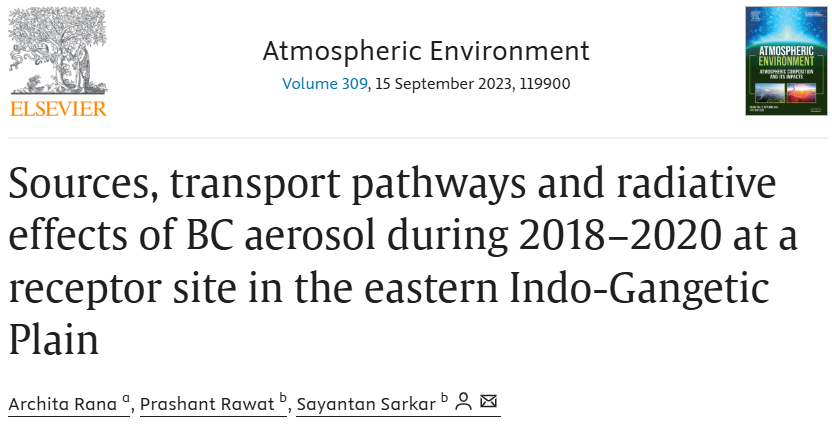
Sources, transport pathways and radiative effects of BC aerosol during 2018–2020 at a receptor site in the eastern Indo-Gangetic Plain
Atmospheric Environment
Archita Rana, Prashant Rawat, & Sayantan Sarkar
2023-09-15
This study reports black carbon (BC) characteristics and climate effects for a 22-month period during 2018–2020 at a receptor location in the eastern Indo-Gangetic Plains (IGP). The overall averaged BC mass concentration was 7.8 ± 4.7 μg m−3, and the nighttime average (9.1 ± 6.1 μg m−3) was nearly double that of the daytime (5.8 ± 3.5 μg m−3). BC was most enhanced during winter, with mean concentration (14.3 ± 3.8 μg m−3) higher by 4 times as compared to summer. A two-component mixing model, frequency distribution of the Angstrom exponent, and a simultaneous increase in brown carbon (BrC) absorption coefficient suggested that this enhancement was mostly due to the biomass burning (BB) fraction of BC. CALIPSO-derived products showed that the extinction coefficient was highest at 0.62 ± 0.31 km−1 in winter and lowest at 0.12 ± 0.05 km−1 in summer. Backscatter plots and particle depolarization ratios indicated presence of spherical dust particles during summer and smoke plumes during post-monsoon and winter. Concentration-weighted trajectories (CWTs) helped in quantifying significant contributions of the IGP outflow to BC, BC-BB and BrC absorption. Finally, a large direct radiative forcing of the atmosphere by BC (37 ± 22 W m−2) was estimated via the radiative transfer model SBDART, with an associated atmospheric heating rate of 1.02 K d−1.
- Higher BC during post-monsoon and winter with nighttime enhancements.
- Skewed Angstrom exponents in these seasons suggest contribution from BrC.
- Backscatter coefficient profile suggests impacts of smoke plumes.
- CWTs indicate NW-IGP outflow as the major contributor of biomass burning aerosol.
- Significant BC-induced direct radiative forcing estimated for the atmosphere.

